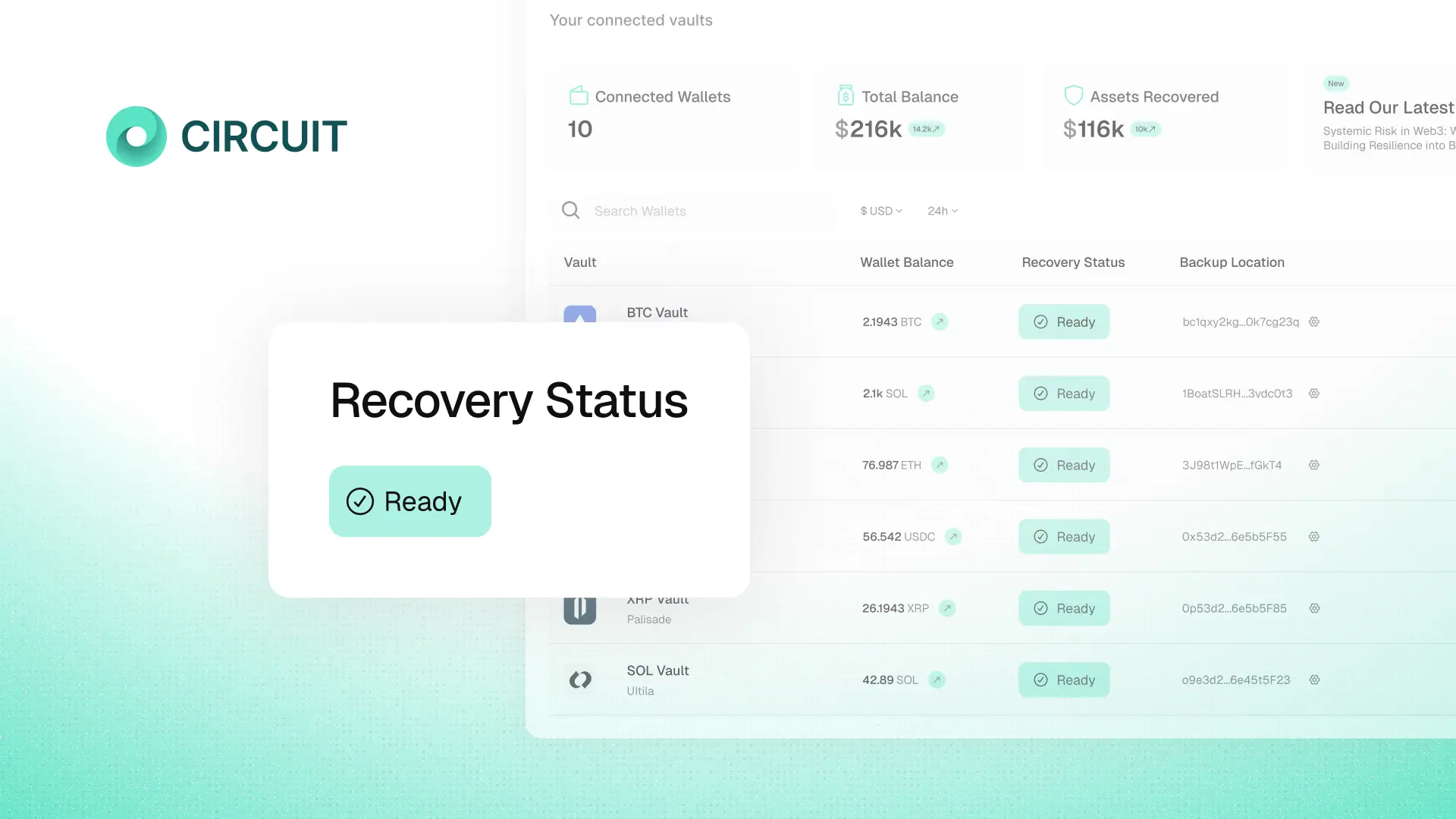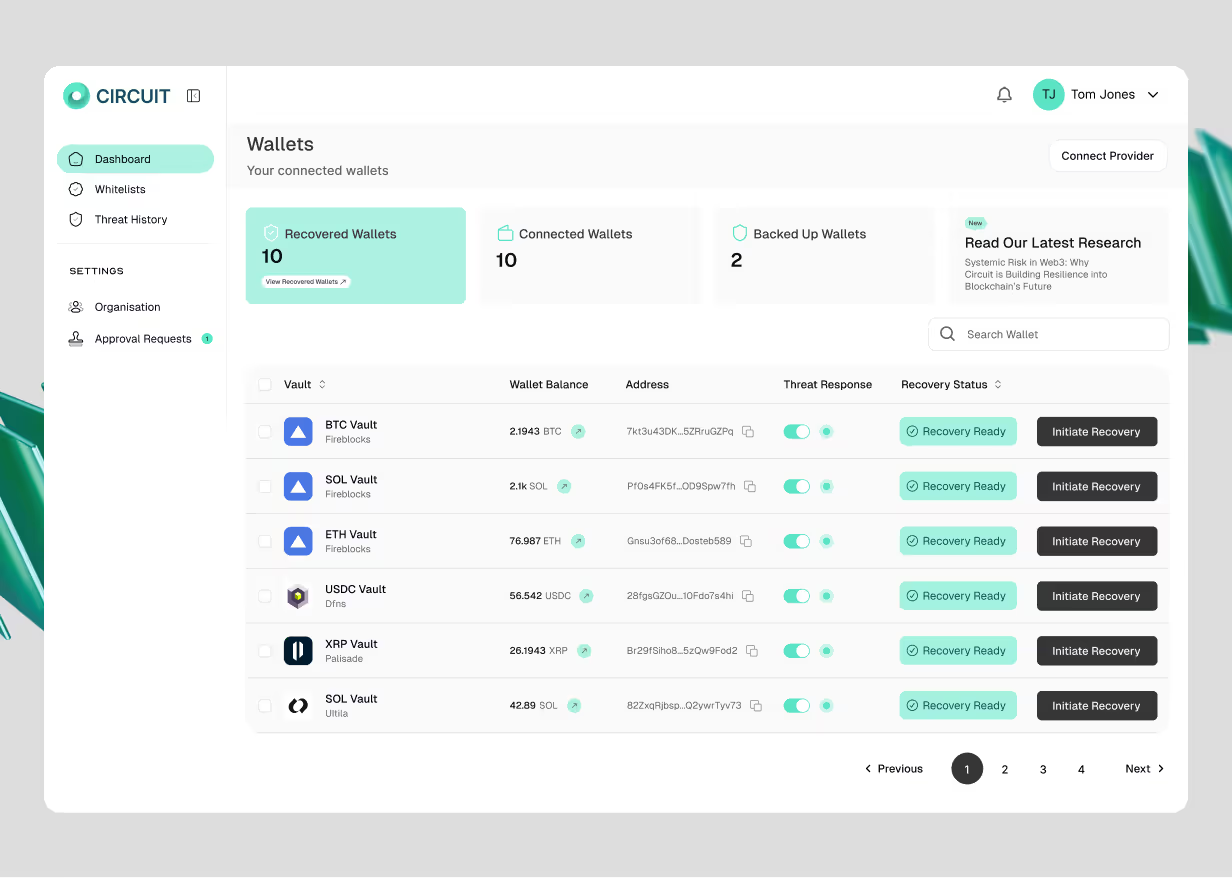
Introduction: You’re Not Behind. You’re Early.
In crypto, recovery planning has historically focused on the private key. When access is lost or disrupted, the default assumption is that the solution lies in reassembling the key — or recreating access to its signing function.
But that assumption is beginning to shift. More teams are recognizing that the real objective isn’t key recovery - it’s asset recovery. And while the two concepts may sound similar, they reflect fundamentally different approaches to business continuity and operational resilience.
Over the past decade, considerable effort has gone into strengthening key management - from improved hardware security to MPC architectures. Yet, when systems fail or come under pressure, most recovery plans still rely on a familiar fallback: reconstruct the private key and resume control.
But what if there were a way to recover assets without needing to reassemble or reintroduce sensitive key material at all?
This shift - toward what we call asset recovery - is gaining attention for a reason. It offers an alternate recovery path that avoids many of the challenges associated with key-based recovery, and it reflects a more mature understanding of operational risk in digital asset infrastructure.
What Is Key Recovery?
Key recovery refers to the process of regaining access to a private key after it’s been lost, deleted, or rendered inaccessible. In institutional environments, this might involve reassembling MPC key shards from backups, or unsealing cryptographic material stored in HSMs.
These methods can be effective, but they introduce several practical challenges:
- Reassembling key material creates a moment of heightened risk - especially if coordination is rushed.
- Recovery typically requires multiple systems and human approvals, each of which introduces delay or uncertainty.
- In high-pressure scenarios, such as legal freezes, breaches, or outages, recovery workflows can become bottlenecks rather than solutions.
In short, while key recovery may be a necessary fallback in some cases, it often creates friction or risk at the exact moment institutions need clarity and speed.
What Is Asset Recovery?
Asset recovery takes a different approach. Rather than focusing on regaining access to the private key, it focuses on ensuring assets can be safely moved - even if the original key or infrastructure becomes inaccessible.
This typically involves:
- Pre-signed transactions that route assets to secure backup destinations, triggered under defined conditions
- Policy-enforced signers that constrain what recovery operations can be performed - and by whom
- Separation of infrastructure, ensuring that recovery mechanisms operate independently of the compromised or unavailable environment
- Auditability and governance, so recovery actions remain verifiable and in line with organizational controls
The key difference is one of control philosophy: asset recovery is proactive. Recovery workflows are defined in advance, approved under policy, and don’t require reintroducing the very key material institutions work hard to keep out of reach.
Why the Distinction Matters
Let’s look at a few scenarios that will be familiar to infrastructure and operations teams:
- A custody provider experiences downtime. Your wallet infrastructure is otherwise stable - but you can’t move funds because a signer is offline.
- Your team conducts a disaster recovery drill. To simulate recovery, you need to retrieve key shards from cold storage, introducing operational complexity and a brief window of risk.
- You detect a potential compromise in your signing system. While sweeping assets to a secure destination is best practice, your only available route requires key reconstruction which introduces critical risk.
- Infrastructure becomes unresponsive without explanation. Even if there’s no confirmed breach, good operational hygiene dictates treating it as compromised. But initiating a recovery flow through that same infrastructure risks compounding the issue.
These are not edge cases. They’re operational realities in high-stakes environments.
Which is why this distinction matters:
- Security: Reintroducing keys reopens threat surfaces previously sealed off.
- Speed: Asset recovery can be executed more quickly and with less friction.
- Governance: Defined flows reduce ambiguity during escalation or enforcement scenarios.
- Resilience: Recovery systems that are independent of production infrastructure are easier to test - and more likely to work when needed.
If the ability to recover hinges on reusing the very infrastructure that failed, the recovery plan may not hold up under real-world stress.
Final Thoughts
As the digital asset ecosystem matures, so too must its approach to risk and recovery.
Key recovery has a place, particularly in edge cases or deep-contingency planning. But for most operational events, it introduces more complexity than it resolves.
Asset recovery isn’t a backup plan for when key management fails. It’s a recognition that, in many real-world scenarios, the ability to move assets safely matters more than the ability to reconstruct cryptographic authority.
This doesn’t replace the need for secure key management - but it does acknowledge that recovery itself should not reintroduce the very risks you’ve worked so hard to eliminate.
Learn More
If this framing is new to you, that’s not a bad thing. It means you’re early.
To explore how asset recovery works in practice:
Read the whitepaper
Book a session with our team
Related Posts
Discover more about Circuit’s latest News and Research

Built by experts who’ve made digital assets safer, and now, recoverable.
We believe asset recoverability is table stakes for the next era of digital assets.



